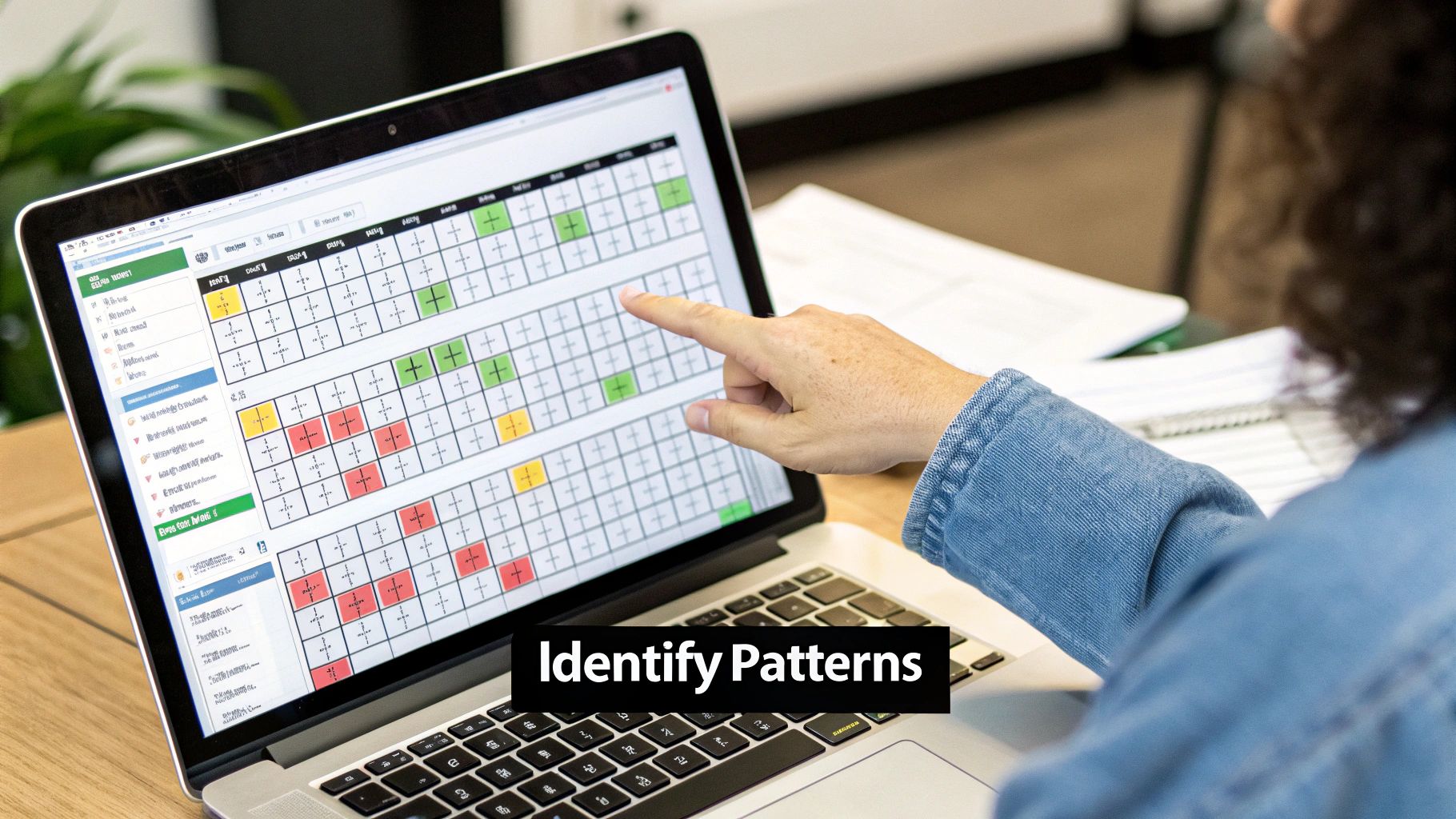So, what does it really take to create a buyer persona? It's all about digging into your audience, spotting the common threads in their goals and frustrations, and then building out semi-fictional profiles of your ideal customers. This is how you stop guessing what people want and start knowing what they actually need. It’s the bedrock of any marketing that works.
Why Buyer Personas Are a Non-Negotiable Tool

Before we jump into the how, let's get clear on the why. Generic, one-size-fits-all marketing is dead. It just doesn't connect anymore. A solid buyer persona acts as the bridge between your business and the real people you’re trying to help, forcing everyone on your team to make decisions based on data, not assumptions.
This isn’t some abstract marketing exercise. It's a practical tool that leads directly to smarter business decisions. When you get what makes your customer tick, you can create things that truly resonate.
Moving Beyond Guesswork
At its heart, building a buyer persona is an act of empathy that’s backed up by hard data. You’re putting yourself in your customer’s shoes and seeing the world through their eyes. This shift from gut feelings to real-world insights sends ripples across your entire company.
- Product Development: Instead of adding features you think are cool, you start building solutions to the actual problems your users have told you about.
- Content Creation: Your blog posts, social media updates, and emails suddenly start answering real questions and addressing known pain points. Your content becomes genuinely useful.
- Sales Conversations: Your sales team can walk into a conversation already knowing the likely objections, motivations, and challenges. The whole pitch becomes more relevant and effective.
A persona isn't just a profile; it's a story. It’s the narrative of your customer’s ambitions, their daily struggles, and that "aha!" moment when they realize your product is exactly what they've been searching for.
The Evolution of Persona Creation
The idea of personas has changed a lot over the years. Early on, they were built mostly from qualitative stuff—interviews, focus groups, and observations. But with the explosion of data, the process has become a powerful blend of both qualitative and quantitative insights. We can now use statistical methods like cluster analysis to validate our assumptions.
This mix of data and storytelling gives you a much more solid foundation for making decisions. These well-defined personas become the cornerstone for all your broader marketing strategies, making sure every campaign, message, and product feature aligns with what your customers truly want. The payoff isn't just more clicks; it's genuine connection and long-term loyalty.
Uncovering Actionable Data for Your Personas
Great personas aren't just dreamed up in a meeting room; they're built on a solid foundation of real-world data. This is where we stop guessing and start digging into the information that reveals who your customers are and what truly motivates them.
To get a complete picture, you need to understand both what people do and why they do it. The best personas come from a mix of research methods. You’ll want to blend the hard numbers from your analytics with the human stories you get from conversations. This combination is key to making sure your personas are accurate and reliable.
Digging into Quantitative Data
Let's start with the numbers. Quantitative data gives you the objective backbone for your personas—it's the "what" behind customer behavior. And good news: you’re probably already sitting on a goldmine of this information.
Your website analytics are the perfect place to begin. A tool like Google Analytics shows you exactly how people find your site and what they do once they're there.

Looking at metrics like session duration or top-visited pages helps you see which content grabs their attention and where they might be losing interest. These are clues to their needs and frustrations.
Your CRM and social media accounts are also packed with useful data. Start looking for patterns in:
- Demographics: What are the common ages, locations, and job titles of your most engaged customers?
- Acquisition Channels: Where are your best leads coming from? Organic search? A specific social platform? Referrals?
- Content Engagement: Which blog posts, emails, or social updates get the most clicks and comments? This tells you what topics they care about.
Keep in mind, quantitative data shows you what is happening, but it rarely explains why. It’s a crucial first step, but it's only half the story.
Gathering Qualitative Insights
To find out the "why" behind the data, you have to talk to actual people. This is where you uncover the motivations, challenges, and goals that numbers alone can't show you. Qualitative research is what breathes life into your personas.
One of the best ways to do this is through customer interviews. These one-on-one chats let you go deep into their experiences with your product or industry. The key is to ask open-ended questions that encourage them to tell a story, rather than just give "yes" or "no" answers. For a detailed guide on this, check out our article on how to conduct user research that drives results.
Tapping Your Internal Experts
Don't forget about the experts sitting right next to you. Your own customer-facing teams are on the front lines every day, and they have an incredible, firsthand perspective on what customers need and what drives them crazy.
Talk to Your Sales Team
Your sales reps know what makes a prospect’s ears perk up. They live and breathe the pain points that send people looking for a solution and know the exact questions that pop up before a purchase.
Ask them things like:
- What are the most common objections you hear?
- Describe the "aha!" moment when a prospect really gets our value.
- What specific words or phrases do prospects use to describe their problems?
Consult with Customer Support
The support team is a treasure trove of insights into how people use your product in the real world. They hear directly from users who are trying to get something done and running into roadblocks.
Find out about:
- What are the top 5 most frequently asked questions?
- What clever workarounds have customers invented?
- Are there any feature requests that come up over and over again?
By weaving together hard data from analytics, compelling stories from customer interviews, and practical wisdom from your internal teams, you’ll build a truly multidimensional view of your audience. This balanced approach ensures your personas are genuine reflections of the people you want to help, not just marketing caricatures.
Finding the Patterns in Your Customer Data

You've put in the legwork and gathered a ton of customer information. Now it's time to sift through it all and find the gold. This stage is all about transforming that raw data—interview transcripts, survey responses, analytics—into real, human stories.
The goal here isn't to get bogged down in every single data point. Instead, you're playing detective. You’re on the hunt for the common threads that link different customers together, from their biggest headaches to their ultimate goals. This is how scattered notes become the clear, actionable groups that will form your buyer personas.
Get Your Research Organized First
Before you can spot any patterns, you need a system. Just dumping all your notes into one massive document is a surefire way to get overwhelmed. A simple spreadsheet is your best friend here.
I like to create a master spreadsheet and use different tabs for each data source—one for interview notes, another for survey results, and so on. Inside the interview and survey tabs, I organize the information by question. This lets you scan down a column and see how everyone answered the same question, making comparisons a breeze.
For instance, your columns could look something like this:
- Demographics: Job Title, Company Size, Industry
- Goals: What are they trying to accomplish?
- Challenges: What’s getting in their way?
- Direct Quotes: Copy and paste those powerful, revealing, or emotional statements.
- Watering Holes: Where do they get their information? (Blogs, specific social media groups, conferences, etc.)
This methodical setup is the foundation for everything else. It keeps you from getting lost in the weeds and ensures your personas are built on solid evidence.
Start Identifying Meaningful Customer Segments
With all your data neatly arranged, you can finally start grouping people. You’re looking for clusters of individuals who share similar behaviors and motivations. This is the essence of market segmentation—carving out smaller, well-defined groups from your broader audience. If you want to go deeper, we have a whole guide on what market segmentation is and how it works.
Don’t get hung up on just one data point, like a job title. A "Marketing Manager" at a 10-person startup has completely different priorities than one at a Fortune 500 corporation. Look for groupings based on their core drivers instead.
You might find one group that’s laser-focused on improving efficiency and saving time. Another might be all about driving revenue, even if it requires a bigger upfront investment. These are the kinds of motivational differences that make for powerful, distinct personas.
Try to identify 3 to 5 distinct groups. Any more, and your marketing will feel diluted. Any fewer, and you might be oversimplifying who your customers really are.
Pro Tip: I love using color-coding in my spreadsheet. Highlight everyone who mentioned "budget constraints" in yellow. Mark anyone who talked about "scaling their team" in blue. These simple visual cues make the patterns practically jump off the page.
Zero in on Their Core Goals and Pain Points
As you comb through your organized data for each group, two things will start to stand out: their primary goals and their biggest pain points. These are the elements that breathe life into your personas.
Always look for the "why" behind what people are saying. A customer might tell you they need new project management software, but what’s their real goal? It’s probably to stop working on weekends. Someone else might say they want better analytics, but their pain point is feeling unprepared for meetings with their boss.
For each segment you've identified, list out the most common goals and challenges you see. Pay close attention to the exact language they use. If you hear three different people describe their current tool as "clunky and slow," that’s a direct quote you absolutely want to capture for that persona.
To guide your analysis, keep these questions in mind:
- What was the trigger? What event or frustration finally pushed them to look for a solution?
- What does a "win" look like? How will they actually measure the success of a product like yours?
- What are their biggest barriers to buying? What makes them pause, hesitate, or look at a competitor instead?
Answering these for each of your groups provides a solid framework. By the end, you won't just have a spreadsheet full of data; you'll have the skeletons of compelling stories about the real people you're here to help.
Building Your Persona Profiles from Scratch
You’ve done the hard work of gathering and sifting through all that customer data. Now comes the best part: turning those numbers and notes into a real, breathing person. This is where abstract data gets a face, a name, and a story your entire team can get behind.
Forget those generic, fill-in-the-blank templates. We're aiming to create a living document that actually sparks empathy and drives smarter decisions. The goal is a clear, scannable, one-page summary for each of your key customer types.
Give Your Persona a Name and a Face
The first move to make a persona feel real is to give it a name and a face. Seriously, this isn't just for kicks; it completely changes how your team relates to the profile. "Marketing Mary" is a lot easier to discuss in a meeting than "Customer Segment B."
An alliterative name like "Startup Steve" or "Agency Anna" makes the persona stick. Then, hop onto a stock photo site and find a picture that feels right. You're looking for someone who looks authentic and natural, not a stiff corporate headshot. It’s a small detail that makes a world of difference.
Craft Their Story
With a name and face locked in, it's time to tell their story. This is where you get to weave in all that great qualitative research—the quotes, the anecdotes, the real-world frustrations you heard about. Think of it as the "About Me" section for your ideal customer.
A good narrative should touch on:
- Their Day-to-Day: What does a typical day look like? What are they actually doing?
- Their Background: A quick sketch of their career path. Are they a seasoned pro or just getting started?
- How They Learn: Where do they get their info? Are they scrolling through LinkedIn, listening to podcasts, or asking peers for recommendations?
This story provides the crucial context behind their actions. Building out these details is a fundamental part of figuring out how to define your target market and ensuring you’re not just shouting into the void.
Pinpoint Their Goals and Challenges
Okay, this is the heart of the persona profile. You need to clearly and concisely state what this person is trying to achieve and what’s getting in their way. Use bullet points here—make it impossible to miss.
For Goals, list 3-4 primary objectives. What does a "win" look like for them, both in their job and for themselves?
For Challenges, list 3-4 of the biggest hurdles they face. What keeps them up at night? What specific frustrations sent them looking for a solution like yours?
Here’s what that looks like in the real world: Imagine you’re building a persona for "E-commerce Emily," a small business owner. Her goal isn't just "increase sales." It's "Automate inventory tracking to win back 10 hours a week." Her challenge isn't "bad software." It's "Feeling swamped by clunky, disconnected tools that cause costly shipping mistakes." Specificity is your best friend here.
Drop in a Real Quote
One of the most powerful things you can add is a direct quote from one of your customer interviews. A single, well-chosen sentence can capture a core frustration or desire far better than a paragraph of your own writing ever could.
Hunt for a quote that's packed with emotion or offers a crystal-clear glimpse into their world. Something like, "I feel like I'm constantly putting out fires instead of actually growing my business." That one line makes the persona’s struggle feel urgent and real.
Lay Out the Key Details
Now that you have the story, you need to provide a snapshot of the essential components that make up this person. The table below breaks down the key elements you'll want to include in every persona profile. This ensures your team has a comprehensive and actionable document they can turn to again and again.
Essential Components of a Buyer Persona Profile
By weaving together a compelling story, clear goals, real quotes, and these scannable details, you’re not just making a profile. You’re building a strategic tool that empowers everyone on your team to make smarter, more empathetic decisions that truly connect with your customers.
Bringing Your Personas to Life in Your Daily Workflow

Creating detailed buyer personas is a fantastic first step, but let's be honest—their real magic only happens when they're actually used. A persona profile gathering dust in a shared drive isn't helping anyone. The final, and most critical, step is to weave these customer stories into the very fabric of your company's daily operations.
This is where all that research pays off. When every department starts thinking "persona-first," your marketing messages hit home, your sales pitches land, and your product actually solves the right problems. It’s all about making your personas a living, breathing part of your culture.
Fueling Your Marketing Machine
For marketers, buyer personas are the ultimate cheat sheet. They cut through the noise and eliminate the guesswork. Instead of creating content you think your audience wants, you can finally create what you know they need.
Let's say one of your personas is "Startup Steve," a founder who's constantly swamped and short on time. Your content strategy immediately clicks into place:
- Blog Posts: Forget long, theoretical essays. You'll create quick, scannable checklists and straightforward "how-to" guides that solve one of his immediate problems.
- Social Media: You know Steve lives on LinkedIn, so you focus your energy there with punchy, value-packed posts instead of spreading yourself thin across every other platform.
- Email Marketing: Your subject lines will speak directly to his pain points. Something like "Stop Wasting Time on Admin Tasks" will get his attention far more than a generic newsletter.
Once your personas are clearly defined, you can get incredibly specific. A great example is learning how to create buyer personas for Google Ads to laser-focus your targeting and ad copy.
Empowering Your Sales Team
A well-researched persona is a sales rep's secret weapon. It gives them a deep understanding of a prospect's world before they even pick up the phone. That kind of empathy builds instant rapport and trust.
By reviewing a persona profile, a salesperson can:
- Anticipate Objections: If "Agency Anna's" profile lists "budget constraints" as a major challenge, the rep can proactively address pricing and demonstrate a clear ROI.
- Tailor the Pitch: They can focus on the specific features that solve Anna’s problems, skipping the fluff she doesn’t care about.
- Speak Their Language: Using industry jargon and referencing common frustrations mentioned in the persona shows the rep truly gets it.
A persona transforms a generic sales script into a personalized conversation. It shifts the dynamic from a pitch to a problem-solving session, which is always more effective.
Guiding Your Product Development
Product teams are always juggling a long list of potential features with limited time. Personas act as the crucial filter for prioritizing what to build next. They ensure your roadmap is driven by real customer needs, not just internal assumptions.
Now, when a new feature is proposed, the team can ask the right questions:
- "Which of our personas would benefit most from this?"
- "Does this solve a core problem for 'E-commerce Emily'?"
- "Is this a nice-to-have or a must-have for our primary customer?"
This persona-centric approach keeps the team focused on delivering genuine value and stops them from building features nobody ends up using. The impact here is huge. Research shows that over 60% of companies that keep their personas updated actually surpass their revenue and lead goals. It's a powerful tool that just plain works.
Common Questions About Buyer Personas
Even with the best roadmap, a few questions always seem to pop up when you're deep in the persona-building process. Let's tackle some of the most common ones I hear from teams just getting started.
How Many Personas Do We Actually Need?
This is easily the first question everyone asks. While there's no magic number, the sweet spot is usually between 3 to 5 distinct personas.
If you have fewer than that, you risk painting your audience with too broad a brush. But if you create too many, your marketing can feel scattered and lose its focus. The goal isn't to document every possible customer type, but to zero in on the groups that drive the most value for your business.
Trust me, it’s far better to have three rock-solid personas that your team knows inside and out than a dozen half-baked ones collecting digital dust.
What If My Data Seems Contradictory?
First off, don't panic. Finding conflicting data is not just normal; it's a good thing. When one customer raves about a feature another one can't stand, you've likely stumbled upon a meaningful difference that can define two separate personas.
Resist the temptation to average out these differences. A major split in goals, challenges, or what they value is a huge clue. For instance, a small business owner who’s extremely price-sensitive has fundamentally different needs than a department head at a large company with a dedicated budget, even if their job titles look similar.
Conflicting data isn't a problem; it's an opportunity. It’s your research telling you that your audience isn't a monolith and that you need to segment them more thoughtfully.
How Often Should I Update My Personas?
Buyer personas are not a "set it and forget it" task. Your market is always shifting, new trends emerge, and your customers' needs evolve. The persona that perfectly captured your ideal client two years ago might be totally off the mark today.
I recommend revisiting your personas at least once a year. This doesn't mean a complete overhaul every time. A quick refresh is often all you need.
- Look at new data: Dive into your latest analytics and CRM reports. Are there new patterns?
- Talk to new customers: A few quick interviews with recent buyers can tell you if their experiences still line up with your profiles.
- Check in with your team: Ask your sales and support folks if the personas still feel real based on the conversations they have every day.
Think of your personas as living documents. An annual check-in keeps them sharp, relevant, and genuinely useful for guiding your strategy.
Ready to build a brand that instantly connects with your ideal customer? The team at Softriver specializes in crafting custom logos and brand identities that bring your buyer personas to life. Get a professional, market-aligned brand in as little as 48 hours. Start your branding project today.







